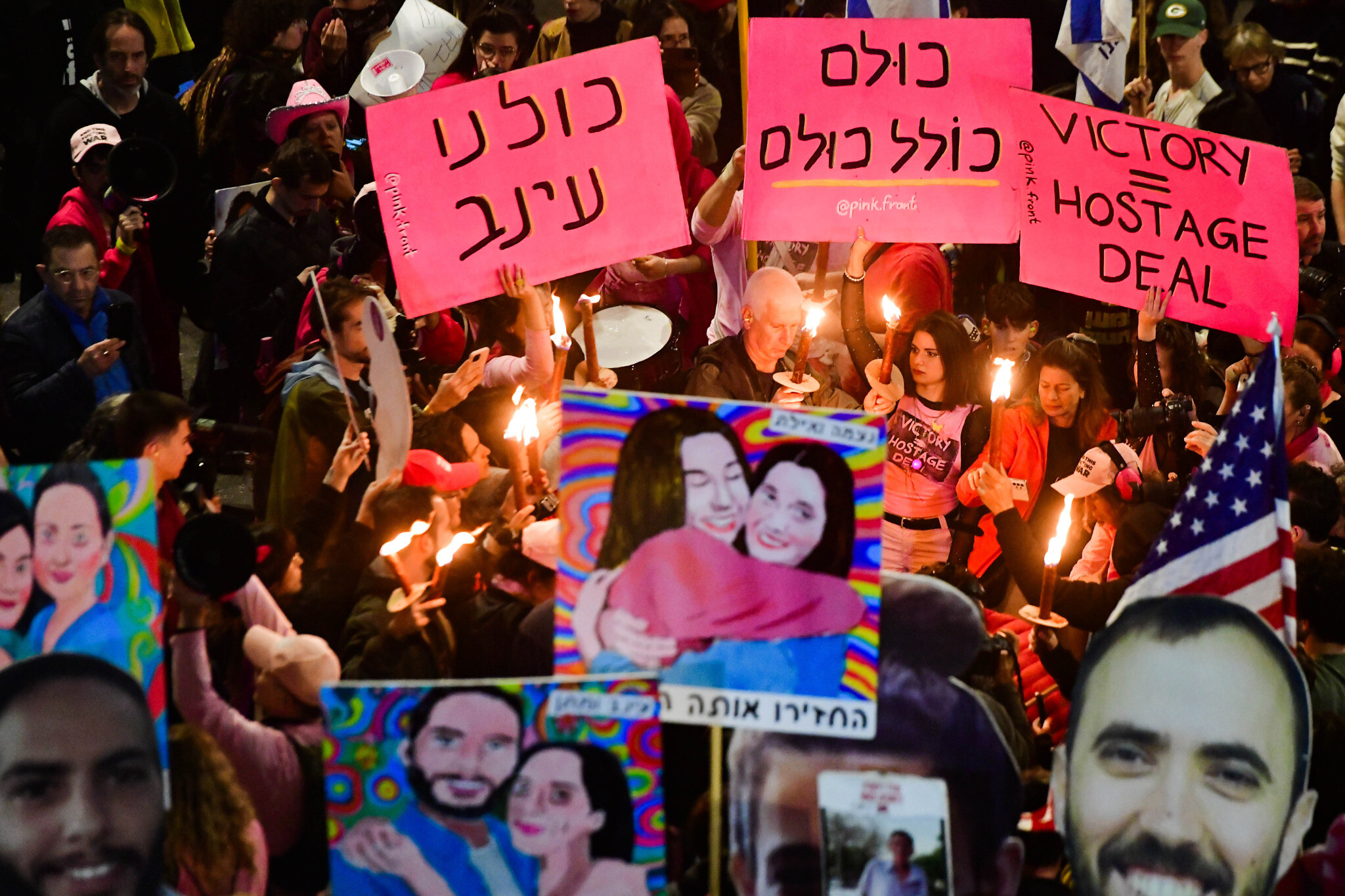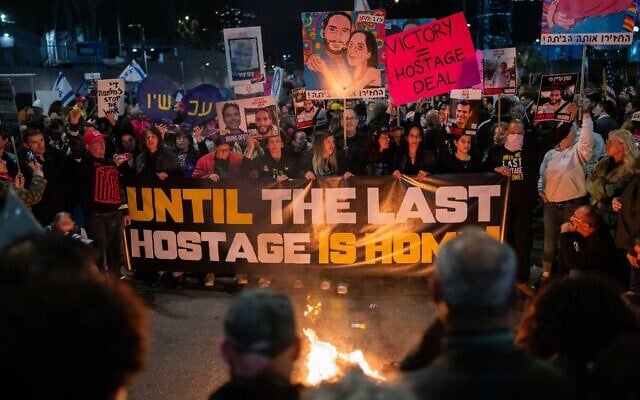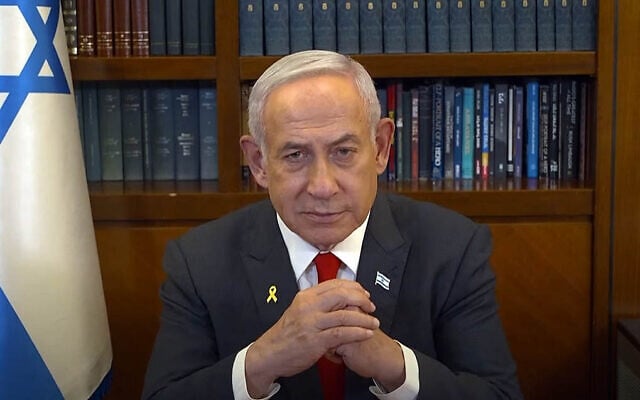



Hours before the hostage release and ceasefire deal between Israel and Hamas was set to begin at 8:30 a.m. on Sunday, the Gaza terror group had yet to release the names of the three hostages it would be releasing later in the day, raising concerns of a wrench having being thrown into the works before the deal even came into effect.
As per the terms of the deal, Hamas is required to provide the names of the hostages at least 24 hours ahead of their release — expected to be on Sunday at around 4:30 p.m.
But 4 p.m. on Saturday came and went, and by Sunday morning, the terror group still had not confirmed which three of the 98 hostages were slated for release later in the day.
A source from within Hamas claimed to the Ynet news site on Sunday morning that the delay in handing over the names was purely due to “technical reasons.”
According to the source, Hamas operatives communicate “physically via emissaries and it takes time to agree on the names and the location of the hostages when IDF planes are still above them.”
“The list will only come out after the approval of Hamas leader Muhammad Sinwar,” the source added.
Amid the delays, Prime Minister Benjamin Netanyahu warned on Saturday night that Israel would not “move forward with the outline until we receive a list of the hostages to be freed, as agreed.
“Israel will not tolerate violations of the agreement,” the statement released by his office added. “The sole responsibility lies with Hamas.”
It was unclear, as of 6:00 a.m. Sunday, whether the ceasefire would take effect as planned at 8:30 a.m., or whether it would be delayed until Hamas provided Israel with information on the hostages due to be released.
In anticipation of the impending deal and at the request of local authorities, the Israel Defense Forces said on Saturday night that schools in southern Israel communities close to the Gaza Strip wouldn’t open before 10:00 a.m. on Sunday.
The military described the move as part of its preparations for the hostage-ceasefire deal, expected will begin 90 minutes earlier, at 8:30 a.m.
According to Hebrew media reports, defense officials assessed that Hamas may fire barrages of rockets at Israel shortly before the ceasefire takes force, as has happened in the past.
As part of its preparations ahead of the ceasefire, the IDF on Saturday also declared the Nitzana Crossing area on the Egypt-Israel border a closed military zone.
The order, signed by IDF Southern Command chief Maj. Gen. Yaron Finkelman, is valid until January 26.
Additionally, the military said that closed military zones in the Yad Mordechai and Kerem Shalom areas will also remain in place until at least January 24.
Israeli civilians who are not residents of those areas, or do not have permission from the army, will not be permitted to enter the closed military zones.
Meanwhile, in the hours leading up to the start of the deal, Hamas-affiliated media reported that Israeli troops were withdrawing from Gaza’s Rafah, which shares a border crossing with Egypt, in anticipation of the start of the ceasefire. Instead, the troops were said to be regrouping along the Philadelphi Corridor along the Gaza-Egypt border.
There was no comment from the IDF on the reports.
The ceasefire-hostage release agreement, which was signed in Doha early Friday and ratified by Israel early Saturday, states that Hamas is required to provide the names of the hostages at least 24 hours ahead of their release.
The first three hostages to be released on Sunday will be civilian women from the list of 33 hostages to be freed in the 42-day first phase of the Israel-Hamas deal, according to Israeli officials.
The Palestinian prisoners to be freed in exchange for the three hostages will not be released before the first hostages are expected back in Israel. Some 95 prisoners are to be released in exchange for the three Israeli women.
In exchange for all 33 hostages, Israel will, by the end of phase one, hand over up to 1,904 Palestinian prisoners and detainees, including several serving multiple life sentences for deadly terror attacks and murders.
Israeli and Hamas negotiators signed the hostage release and ceasefire agreement in Doha in the early hours of Friday morning. The successful deal was initially announced on Wednesday, but the negotiating teams continued meeting afterward in order to iron out final implementation details.
It was then approved by Israel’s security cabinet on Friday afternoon, and then by the full cabinet on Friday evening, in an hours-long discussion and vote that extended long into the night.
Of the 251 hostages abducted by Hamas during the October 7, 2023 invasion and massacre in southern Israel, 94 are believed to remain in Gaza, including the bodies of at least 34 confirmed dead by the IDF.
Hamas released 105 civilians during a weeklong truce in late November, and four hostages were released before that. Eight hostages have been rescued by troops alive, and the bodies of 40 hostages have also been recovered, including three mistakenly killed by the military as they tried to escape their captors.
Hamas is also holding two Israeli civilians who entered the Strip in 2014 and 2015, as well as the bodies of two IDF soldiers who were killed in 2014.
While the administration of outgoing US President Joe Biden played a major role in helping shepherd talks over the past 15 months of war between Israel and Hamas, and almost got a deal over the finishing line several times, it only succeeded once, resulting in a weeklong truce in November 2023, during which 105 hostages were released.
In light of the deal secured in Doha last week, some have pointed to US President-elect Donald Trump as having made the difference in the negotiations, after he dispatched his Middle East envoy Steve Witkoff to the region earlier in January.
Witkoff was rumored to have leaned heavily on Prime Minister Benjamin Netanyahu to pave the way for the breakthrough in negotiations.
A source familiar with the conversations between Witkoff and Netanyahu told the Wall Street Journal on Saturday that Witkoff had reminded the premier that Trump “has been a great friend of Israel,” and suggested it was now “time to be a friend back.”
According to the same report, Trump’s frequent threats of there being “hell to pay” should the hostages not be released by the time he enters the White House on January 20 were not aimed solely at Hamas, but also at Netanyahu.
Trump, on Saturday, told NBC’s “Meet the Press” that he expected the hostage deal to hold throughout all three of its multi-week phases.
Asked if he was confident that the hostages held by Hamas would soon be freed, Trump said “We’re going to see very soon,” and warned that the agreement “better hold.”
He said that when speaking to Netanyahu, he had told the premier to, “Just keep doing what you have to do. You have to have — this has to end. We want it to end, but to keep doing what has to be done.
He also told the media outlet that he would be meeting with Netanyahu “fairly shortly,” but declined to elaborate further.
His incoming national security adviser Mike Waltz was said to have echoed the same sentiments during a meeting with the families of US hostages held in Gaza.
According to a report Saturday, Waltz told the families during a meeting that the Trump administration would make sure that all phases of the ceasefire and hostage release agreement are implemented after the families expressed concern that Netanyahu’s government would resume fighting after the first 42-day phase of the deal, putting the lives of their relatives slated for release in the second and third phase at risk.
The concern followed recent comments by far-right Finance Minister Bezalel Smotrich, who claimed he had received assurances from Netanyahu that Israel would resume fighting after the first phase, the Axios news outlet reported.
The families asked Waltz that the Trump administration push for negotiations on the second phase of the deal to begin as soon as possible, rather than waiting for the 16th day of the ceasefire as the deal stipulates, the report said.
In comments of his own on Saturday evening, Netanyahu all but avoided acknowledging the second and third phases of the deal, during which the remaining 65 hostages are to be released and a permanent ceasefire instituted in Gaza.
Instead, in a 10-minute-long pre-recorded video, the premier referred to the first stage of the deal as a “temporary ceasefire,” and stressed that both Biden and Trump had underlined that Israel could return to fighting in Gaza if the next stages of the deal are not realized.
Overnight in Gaza, fighting continued right up until the early hours of Sunday morning, and the Hamas-run civil defense agency reported that at least five members of one family were killed when an Israeli strike hit their tent in the southern city of Khan Younis.
The Hamas-run agency does not differentiate between civilians and combatants, and its numbers cannot be independently verified.
Hundreds of aid trucks were waiting at the Gaza border ahead of Sunday, poised to enter from Egypt as soon as they get the all-clear to deliver desperately needed aid to the Palestinian territory.
Egyptian Foreign Minister Badr Abdelatty said 600 trucks a day would enter Gaza after the ceasefire takes effect, including 50 carrying fuel.
The majority of Gaza’s 2.3 million residents have been displaced by the war, many more than once. According to an IDF assessment last July, some 1.9 million people were residing in the Israeli-designated “humanitarian zone.”
The zone is located in the al-Mawasi area on the southern Strip’s coast, western neighborhoods of Khan Younis, and central Gaza’s Deir al-Balah.
Its size has changed multiple times, amid evolving IDF operations.
The Strip’s Hamas-run health ministry says more than 46,000 people in the Strip have been killed or are presumed dead in the fighting so far, though the toll cannot be verified and does not differentiate between civilians and fighters.
Israel says it has killed some 18,000 combatants in battle as of November and another 1,000 terrorists inside Israel on October 7.
Israel’s toll in the ground offensive against Hamas in Gaza and in military operations along the border of the enclave stands at 407. The toll includes a police officer killed in a hostage rescue mission and a Defense Ministry civil contractor.





